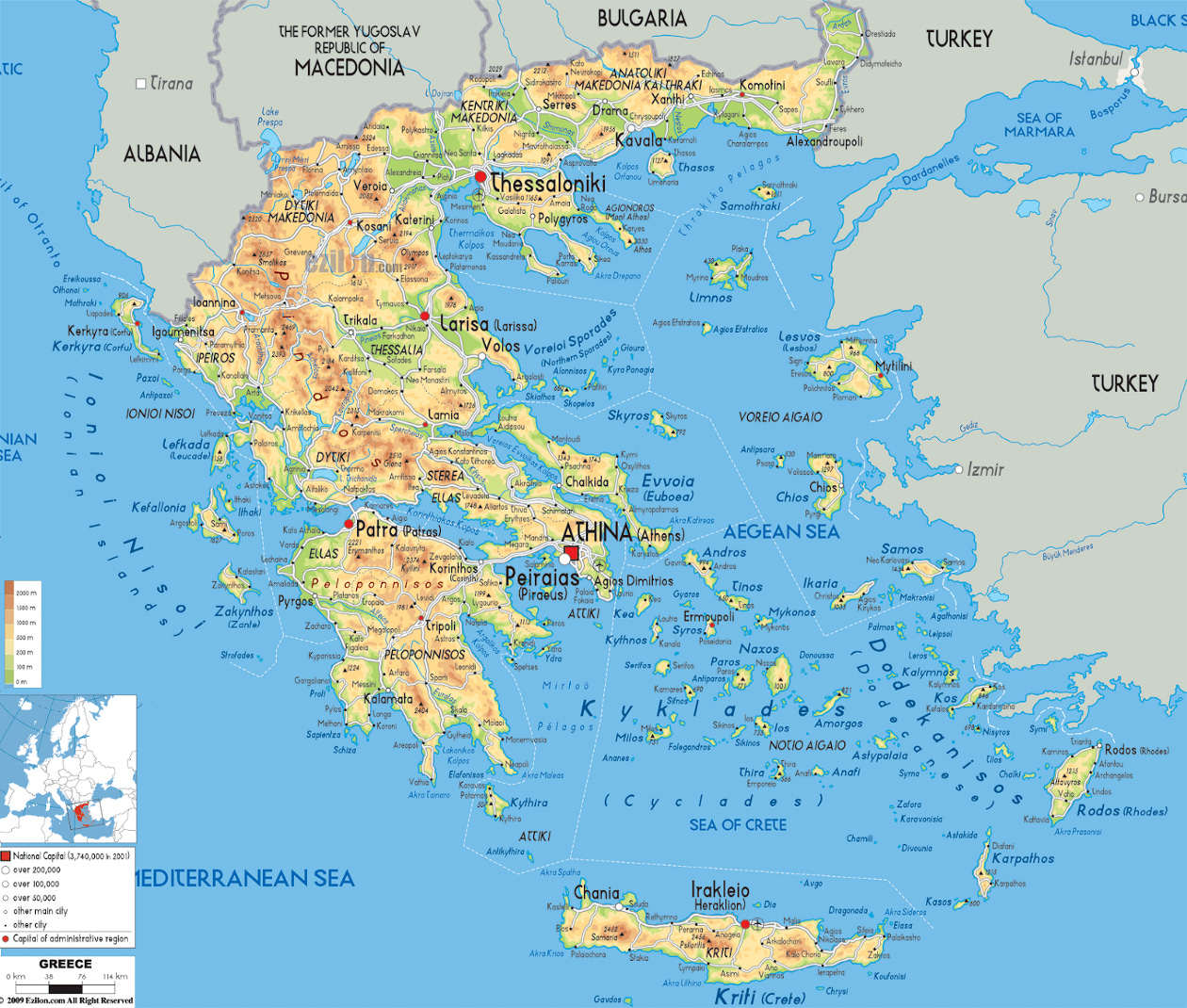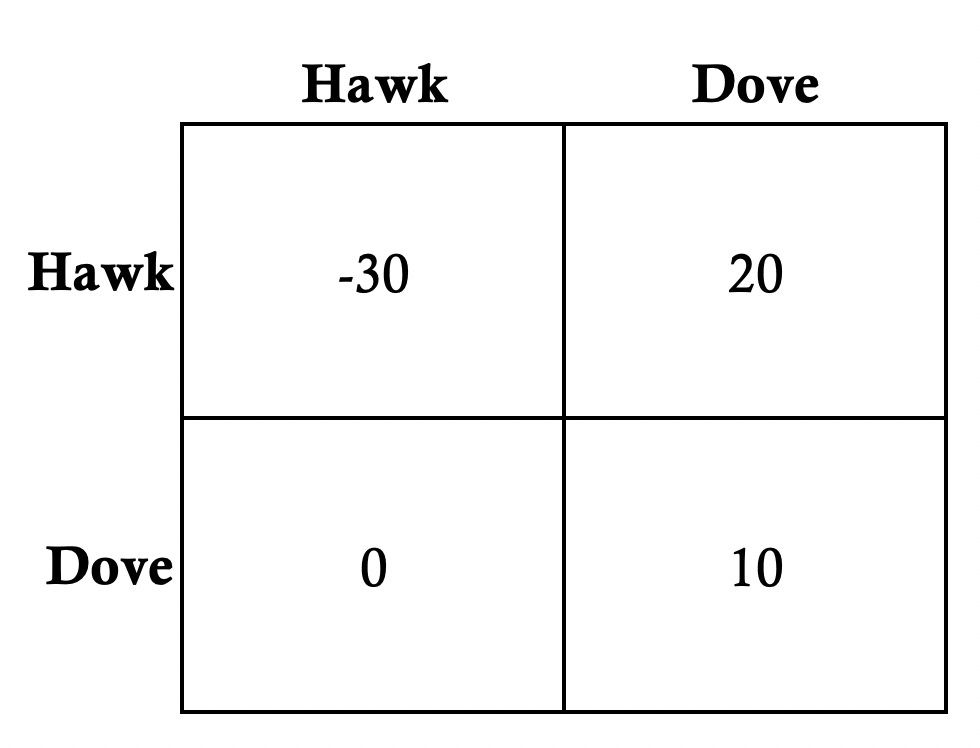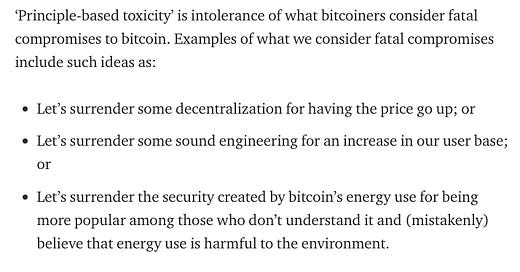

Discover more from The Freedom Analects
Sovereignism Part 3: Mega-Politics, The History and Logic of Violence
A 12-part essay series exploring the disruption of the nation-state and the subsequent amplification of individual sovereignty during the Digital Age.
This series is loosely based on the 1997 masterwork: The Sovereign Individual.
“Exodus believes in empowering the individual to control their wealth and financial destiny and has provided financial support for the research and writing of this series. Exodus has no editorial control over the content of these writings.”
In Part 2, we looked closely at the key catalytic innovation in the global transition to sovereignism: Bitcoin. Functioning as the “ultimate offshore bank” of the 21st century, Bitcoin is an indispensable instrument for intrepid sovereignists setting sail onto the digital high seas. In Part 3, we analyze the mega-political variables that have galvanized human socioeconomic organization and the logic of violence across history, and how changes in these key civilizational considerations will shape the future.
Mega-Politics
“If you know nothing else about the future, you can rest assured that dramatic changes will be neither welcomed nor advertised by conventional thinkers.” — The Sovereign Individual
Mega-politics is the study of macrostructural patterns reverberating across the history of civilization. An unperceptive student of history may be forgiven for the mistaken belief that political manifestos and decrees direct socioeconomic organization. Although marginally true, there exists more fundamental yet less obvious factors shaping the major structural patterns of societies over time. Mega-political variables — including topography, climate, microbiology, and technology — historically account for the vast majority of variability among mankind’s many modes of socioeconomic self-organization. Largely outside the scope of any conscious control, these poorly understood elements shape the channels through which human energy is focused and political power is exercised. Countless livelihoods have been curated by the configuration of these non-obvious boundaries to human action.
Topography is the most apparent mega-political variable: landscape topology and access to seascapes largely determine the costs of distribution and defense. Mountainous regions have given refuge to many ungovernable populations simply because the cost of “projecting power uphill” is prohibitively high. Aquatic access enables the use of energy efficient trade routes and the staging of naval forces to defend economic networks. Ancient Greeks, for instance, enjoyed a high ratio of shoreline to land space, letting them generate high incomes on small plots by exporting oils, olives, and wines efficiently. Wealth accumulation engendered by access to the sea enabled Greeks to arm themselves and deploy a competent navy to shield their growing capital stocks from plunderers.
“The fractal shoreline of the Greek littoral meant that most areas of Greece were no more than twenty miles from the sea… The famous hoplites of ancient Greece were farmers or landlords who armed themselves at their own expense.” — The Sovereign Individual
Climate is a clear mega-political condition shaping the boundaries of human settlement. Although somewhat predictable over the span of decades, climate is constantly in flux, and highly unpredictable over shorter time horizons. Critically, seasonal weather fluctuations can dramatically impact crop yields. Even mild changes to climatic patterns can significantly shift mankind’s agricultural strategies: for instance, a temperature drop of even 1 degree Celsius can reduce growing seasons by 4 weeks and the max elevation for crop-growing by 150 meters. Historically, sudden shifts in climate have been disruptive to agricultural incomes and food production, in many instances “sowing the seeds” of political instability and revolt. Shifting weather can also significantly stimulate or suppress the influence of another key mega-political variable — microbiological conditions.
Microbiology is a largely invisible variable that, before the 20th century, was poorly understood. Each human body is a marketplace of microbes who depends on a certain degree of ecological balance to survive and thrive. Cultures that we typically consider as a nexus of customs and common ideas are often also cultures of common microbiology. Specific populations are often similarly resistant or susceptible to foreign microbes, a dynamic which has significantly shaped the outcomes of cultural commingling historically. Lacking immunity to foreign microbes caused Native American populations to die off in droves after first encountering European settlers in the 15th century. In this case, a lethal contagion cleared a path for European conquest in the New World, but microbiology can also be defensive. Despite strong militaristic advantages, vast tropical regions of Africa were unconquerable by Europeans for centuries because they lacked sufficient immunity to malaria, whereas Africans had evolved a resistance (a defense which is, unfortunately, related to the prevalence of sickle cell syndrome).
As civilization has advanced, these three mega-political variables — topography, climate, and microbiology — have been gradually eclipsed in terms of importance by the fourth: technology.
Technology changes how humans relate with the other three mega-political variables. By applying the human intellect, more powerful and precise ways of channeling a wide variety of energies across spacetime have been achieved. Explosives, earthwork engineering, and land reclamation have enabled humans to resurface the topography of the Earth to make it more habitable. Though manual control over climate patterns remains beyond the reach of technology today, many modern devices make formerly uninhabitable places livable. For instance, several areas in the southeast United States were totally unlivable prior to the invention of air conditioning. Near the pinnacle of technology’s impact on humanity is the discovery of antibiotics, which increased life expectancies by over 50% within the span of a few decades. Of course, the human struggle with microbiological threats is ongoing, as COVID-19 has so clearly demonstrated, but medical technology is the most efficacious modality for reducing human exposure to the entropy of disease.
Technology is also a critical mega-political variable because it provides ever-more sophisticated means of attack and defense. Both World Wars during the 20th century can be thought of as theatres of violent technological demonstration: a plethora of 2-legged apes testing the efficient marvels of carnage developed in the Industrial Age. Man-made tools and technologies serve as the fulcrum of a crucial concept in socioeconomic organization: the logic of violence. In many ecologies, violence is a proven strategy for securing sustenance, territory, and capital. Inter-organism predation is a common survival strategy in nature. Human socioeconomic organization today is bound by violence because it yields profits to those who specialize in it.
Since violence pays, it is inherently hard to control, as it is a pattern of action impelled by Darwinian self-preservation. Said differently, in the Rosseauian state of nature, violence is a useful strategy for profitably obtaining desired outcomes derived from the work of others: rather like a cow grazing on sunlight harvested within the leaves of grass or a man subsequently devouring the solar energy collected within the steak of the cow. All competitive strategies are sculpted by the pursuit of profits — whether these are psychological, energetic, or financial profits makes little difference.
Profitable activities are inherently hard to control, as there are few more potent stimulants to human action beyond this primeval motive. But in the 21st century, the logic and profitability of violence and coercion are in a paradigmatic shift. A transformation in the methods and affordability of defense against these offensive forces is underway thanks to the new mega-political realities of the digital world. Encryption is an exceptionally potent technology with socioeconomic consequences akin to metallurgy or gunpowder. Encryption alters the logic and applicability of violence and coercion by advancing the effectiveness of defense while simultaneously collapsing key components of its cost structure. With encrypted digital toolsets, users can erect impenetrable walls around data (and, thanks to Bitcoin, capital) at near-zero cost. The consequences of this technology are staggering. To fully appreciate the implications of collapsing the cost of defense for civilization, we must first explore the logic of violence embedded in its extant structure.
The Changing Calculus of Violence
“The nation-state facilitated systematic, territorial-based predation.” — The Sovereign Individual
Given the mutual antagonisms which can arise among market actors, violence (or at least, the threat of force) is necessary for the preservation of peace. Securing the economic networks which constitute free markets is the purpose of government: the social apparatus of compulsion and coercion. Court systems, police, and military expenditures collectively comprise the “network security” costs necessary to protect the social division of labor — the sole generator of all wealth in every economic network. Specialists in violence have always been necessary to preserve life, liberty, and property; in other words, to protect market actors from violence, extortion, and coercion. The prices specialists in violence were able to charge in the Analog Ages were typically high and rising, as security is an indispensable service for preserving fruitful social cooperation and commercial activity.
Protection is an inherently centralizing industry. Each time there is a competitive conflict between two protection-producing enterprises, the victor is preferred by all prospective customers, as no one wants to work with the second best physical security provider, who, having been defeated, is always vulnerable to the whims of the best. Said simply: protection services are prone to agglomerate into geographic natural monopolies. In the “winner take all” marketplace of protection, the supreme specialist in violence over a given territory is, by definition, its government. Boundaries between governments, of course, are drawn by the interplay of mega-political variables. Within such boundaries historically, violence specialization has typically driven governance centralization. As Frederic C. Lane describes this progression toward the monopolization of violence and the emergence of government:
“Once it had eliminated from the territory of its monopoly all competing specialists in the use of violence, it could reduce the costs of policing that territory and of exacting payments from its farmers, craftsmen, and local traders. It could reduce the costs it incurred in producing and selling protection, unless there was a dangerous threat from outside. Costs could be further reduced if the government acquired legitimacy, either through mere time and custom, or through ceremonial and religious acts, or through any forms of appeal to opinion that established legitimacy and were less costly ways of controlling violence than expenditure on the police force… Reduction in the costs of a protection-producing enterprise did not necessarily lead to any reduction in its exactions. Being a monopoly, it could keep up its ‘sales price’ or even raise the price up to the point at which it encountered a kind of sales resistance, namely, difficulty in collecting taxes, or at which it invited the entrance of a competitor into the territory monopolized. Lowering costs, while establishing the highest prices the traffic would bear, gave the protection-controlling enterprise an excess of income over costs. This was a special kind of monopoly profit (or producer’s surplus) which it seems appropriate to call, for convenience, by the name of tribute.”
Few today realize that centralized government arose simply as a natural monopoly on violence. Paradoxically, no other business model in history has been so apt at violating the life, liberty, and property of its customers. There has always been a virtually irresistible temptation to wield monopolies on violence to extort wealth from the very citizens they are socially contracted to protect. Infamously high prices and low quality of services — like those rendered by nation-states throughout the world today — are among the inevitable adverse consequences of centralizing power. Monopolists are free to charge high prices so long as their customers lack optionality, and customers have no choice but to pay up since protection is such an essential service.
Since the beginning of the Industrial Age, economic growth enabled entrepreneurs to absorb rising costs of protection. So long as the division of labor was deepening, rising wealth creation was able to offset (non-consensual) increases in nation-state enforced network security costs — which include (non-consensual) taxation, inflation, and conscription. Market actors tolerated extortion because there were still profits to be made under the protection of government. In the Digital Age, encryption technology is disrupting the established balance between extortion and protection. The implications for even the most monolithic Industrial Age institutions — central banks and nation-states — are of existential proportions. Revenue models for all modern nation-states depend on property that can be readily plundered (via seigniorage, taxation, inflation, or conscription). The dominant institutions of the Industrial Age are becoming decreasingly capable of extorting citizens at scale in the Digital Age, since encryption protects citizen-owned digital property from forced seizure.
Clearly violence and coercion are decreasingly effective, but less clear is the path that brought civilization to this point. How has the organization of violence influenced the configuration of civilization historically? Fascinatingly, it appears to be a part of a brutal, auto-catalytic process from which capitalism ultimately emerged as the dominant resource strategy of the 20th century.
Bootstrapping by Violence
“Past mega-political transitions such as the fall of Rome and the feudal revolution in the year 1000 were markers of the waxing and waning power equations that composed governments and caused the spoils of farming to pass from one set of hands to another.” — The Sovereign Individual
As previously discussed in this series, state capitalism outcompeted communism in the 20th century: by better assimilating localized pools of knowledge via the price signal, capitalism generated a great deal more wealth than communism, finally leading to the financial collapse of the USSR and the end of the Cold War. As a prologue to Schumpterian capitalism properly understood, Frederic C. Lane lays out a 4-stage theory of economic development based on the organization and profitability of violence historically:
Stage 1: Plunder runs rampant and pure anarchy is the dominant mode of social organization; an environment akin to the age of Hunters and Gatherers or the Rousseauian original State of Nature. Violence is a highly competitive enterprise at this stage: the costs of protection are high and the margins for specialists in violence are razor thin. Successfully neutralizing local dissidents and securing the borders of geographic enclaves eventually leads to peaceful areas conducive to the establishment of social cooperation and commercial enterprise. Citizens of these primitive governance models lack options and mobility, and therefore yield the vast majority of economic surpluses generated to their monopolistic overlords in an effort to subsist and survive. Such establishment of well-defended regional or provincial commercial hubs, initially as small natural violence monopolies, leads to the second stage.
Stage 2: Insulated from plunder and anarchy by protection-providing enterprises, well-defended enclaves of agricultural and commercial production begin creating ever-larger economic surpluses. Governments, by holding a natural monopoly on violence over these enclaves of production, capture most of this rising surplus. As monopolists with no endogenous competition, the costs of defense rendered by governments can be amortized over time while the attendant revenues (taxes) can be increased to the maximum point the underlying productive economy will bear, or exogenous competition is solicited. As profit-seeking providers establish firmer monopolies, they begin offering protection at lower prices (tax incentives) to prospective citizens than can bring new lands into cultivation or new businesses into operation. The resultant increase in production is a boon to the economic surplus generated, which stimulates interregional trade among properly protected enclaves. These traders then begin to generate jurisdictional arbitrage profits (what Lane calls “protection rents”) by obtaining lower costs of protection through an admixture of cunning, bribery, insurance, and self-defense. A 3rd stage is reached when the profits flowing to merchants exceed those flowing to governments.
Stage 3: Due to jurisdictional arbitrage, productive enterprises now receive more of the economic surplus generated by the division of labor than governments. At this stage, private businesses yield increasingly higher incomes than monopolies on violence. Since the success of merchants is largely derived from intelligent investing, they exhibit a higher propensity to reinvest the profits they earn from their now higher proportion of the economic surplus. This results in a positive feedback loop of expanding commercial enterprises, agricultural improvements, innovation, and new industry. The 4th and final stage is reached when technological innovation becomes the greatest source of profitability in the marketplace.
Stage 4: In this final stage of economic development antecedent to the emergence of capitalism, a political class of rich merchants proliferates, and monopolies on violence come increasingly under the control of their citizens, as reflected in the proliferation of democratic governance models. Newly wealthy, the luxuries of modern morality and virtue flourish. Capital and credit markets — which were created to serve the enterprises of violence and protection — begin to serve agricultural, commercial, and industrial ventures (since production complexity and profits are now greater in these sectors). At this point, the Laniean prologue sequence of economic development gives way to Schumpterian capitalism.
This Laneian sequence of economic development can be thought of as a socioeconomic bootstrapping process. In a software bootstrapping process, computers initially run a self-referential program (for instance, a C compiler written in the C language) that loads and executes steadily more complex programs to activate a self-sustaining process proceeding without external input. Faster programming and more feature rich environments emerge at each higher level of abstraction from the hardware substrate. Some version of this abstractive process occurs each time a computer boots up. Similarly, mankind ascends into steadily more complex stages of social organization (programming) and economic production (features) through bootstrapping. The kernel of this socioeconomic bootstrapping process is sacrifice: ancient humans’ painfully discovered idea to delay present gratification with the aim of enhancing future consumption. Initial boundary conditions to bootstrapping are based on the utility of violence, including its expected economic returns, sociocultural acceptance, and institutional encoding.
In stage 1, humanity is sorting out the physically robust and virile individuals from the weak. In stage 2, more complex modes of human self-organization crystallize, and network security for trade expands, thereby supporting the division of labor and the build up of human potential energy (as capital) before a tipping point is reached. In stage 3, when a sufficient capital stock has been accumulated and local peace established, politics emerges as intelligence and cunning become more important leadership qualities than overt violence. As a result, those most skilled in violence are pushed to the edges of the economic network, into the enterprise of territorial expansion. Like a mycelial organism beginning to bear its reproductive mushrooms, once adequate energy has been harnessed, government-insulated economies expand into adjacent geographies, an endeavor which often entails armed conflict with other governments. Finally in stage 4, technological productivity has become the main source of wealth creation, and the mega-political variable of technology — the indexing of atoms to ideas — becomes the dominant determinant of human self-organization. With capital accumulation alleviating poverty and communications technologies accelerating the Darwinism of ideas, modern “useful fictions” like civil liberties, human rights, and democracy begin to flower.
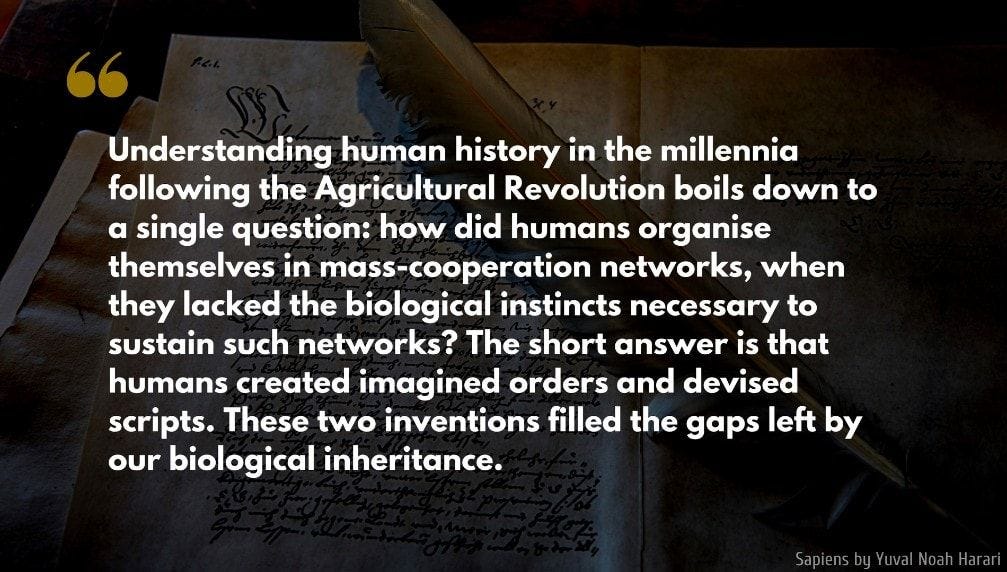
Sovereignists will live to see the post-state-capitalism stage in this sequence of economic development: the generation of a sufficiently sophisticated capital stock of hardware, software, and digital tools that nullifies the coercive influence of nation-states by empowering individuals with a broad and evolving spectrum of optionality in domains critical to self-agency such as capital, weaponry, location, identity, anonymity, communications, and self-defense. No one knows exactly what the (likely manifold) implementations of sovereignism will look like, but its emergence as a guiding civilizational ideology is as certain as the biological principles propelling it into existence. Lovers of peace worldwide will soon find cause for celebration, as sovereignists are incentivized to cooperate and compete non-violently. Expect to see global cultures characterized less by hawkishness and more by dovishness as the 21st century continues.
A Weapon of Peace
“When defensive capabilities are rising, it becomes more costly to project power outside of core areas, causing jurisdictions to devolve and big governments to fracture into smaller ones.” — The Sovereign Individual
Evolutionary game theory can give us a deeper understanding of the impact theft-proof capital has on the global configuration of power, wealth, and socioeconomic organization. In the evolutionary game-theoretic model of Hawks vs. Doves, all hawks and doves are equally strong: each has an equal chance of winning a competitive encounter with any other. However, hawks and doves each adopt distinctly divergent strategies: hawks always escalate a conflict, whereas doves always back down if their opponent escalates.
Let’s assume that in this game 20 points (in evolutionary game theory, called fitness payoffs) are rewarded for winning a competitive encounter, and 80 points are lost due to injury if an opponent escalates the conflict and loses (again, only hawks escalate conflicts). When two hawks compete, neither backs down, so by running an expected value calculation on fitness payoffs we determine that the average hawk loses 30 points when competing with another hawk [(50% * 20)+(50% * -80)] = -30. In a purely hawk vs. hawk world, hawk fitness suffers. When two doves compete, each wins half of the time, but no dove gets hurt since doves do not escalate conflicts. Therefore, the expected value calculation of fitness payoffs for the average dove fighting another dove is 10 points [(50% * 20) + (50% * 0)] = 10. In a purely dove vs. dove world, dove fitness improves. Intermixing populations adds new wrinkles to the game: when a hawk competes with a dove, the hawk wins (20 pts), the dove loses (0 pts), and there are no injuries (since doves back down from escalation). This matrix summarizes the game, which shows the expected fitness payoff to the strategy on the row when competing against the strategy in the respective column:
Natural selection favors the strategies most fit to their environments. A major component of this fitness is the proportion of competing strategies faced off against in the environment (aka the proportions of hawks and doves in the population). Ignoring other environmental factors in this simplified game, if the population is 100% hawks, then everyone loses an average of 30 points in each competition — a fast track to extinction. If the population is 100% doves, then everyone gains an average of 10 points in each competition — a fast track to greater fitness. The catch is when there is a niche: in a population of 100% doves, when a hawk shows up it has a heyday, winning 20 pts from every encounter with a dove, whereas doves have an expected value of 10 pts competing with other doves and 0 pts competing with hawks. More fitness points means more reproduction, so the hawk population expands disproportionately at the expense of doves. The hawk population stops growing at 25% of the total, based on the mathematics of the fitness payoffs matrix.
Now, let’s instead assume an increase in the ratio of reward to risk in this evolutionary game, where 40 points are gained for winning and 60 points are lost for an injury. Changing assumptions cause the strategic equilibrium to shift, as reflected by the proportion of hawks and doves in the total population. Based on these fitness payoff assumptions, at equilibrium 67% of the population will be hawks. This matrix summarizes the game with the updated assumptions:
Fitness depends not only on payoffs, but also on the strategy employed against the prevalence of competing strategies. If everyone is a dove, it’s more fit to be a hawk; if everyone is a hawk, it’s more fit to be a dove. The key point: fitness does not mirror the world. It depends in complex ways on the state of the world, the state of the organism, and the frequencies of strategies. Gaining territory (and its human expression, private property) is the underlying source of fitness payoffs — the points earned in Darwinian competition. But what happens when the private property rewarded for winning an economic dispute decline to near-zero? This is the inescapable consequence of theft-proof money on the Darwinian aspects of economic competition.
To extend this game into economic reality, we could consider the rewards for winning either favorable judgements, confiscated property, legal monopolies, tax revenue, inflation, tributes receivable, or other political privileges forcibly obtained through conflict. “To the victor go the spoils,” as the aphorism states. Injuries incurred following the escalation of economic conflicts might include unfavorable judgements, legal expenses, military spending, wasted time, tributes payable, enslavement, or capital consumption. Since Bitcoin is virtually immune to all legal judgements, decrees, political authority, involuntary taxation, confiscation, and inflation — an economy operating on a theft-proof monetary standard collapses the fitness payoffs of winning socioeconomic struggles to near-zero, since involuntary value exchange is all but eliminated. When the monetary rewards for winning zero-sum games at the interpersonal, socioeconomic, and geopolitical levels approaches zero while the cost of injury remains positive, the dominant strategy becomes dovishness. As a result, hawkish strategies rapidly decline toward extinction — a mathematical trajectory favorable to the emergence of sovereignism as clearly explicated in the summarizing game matrix:
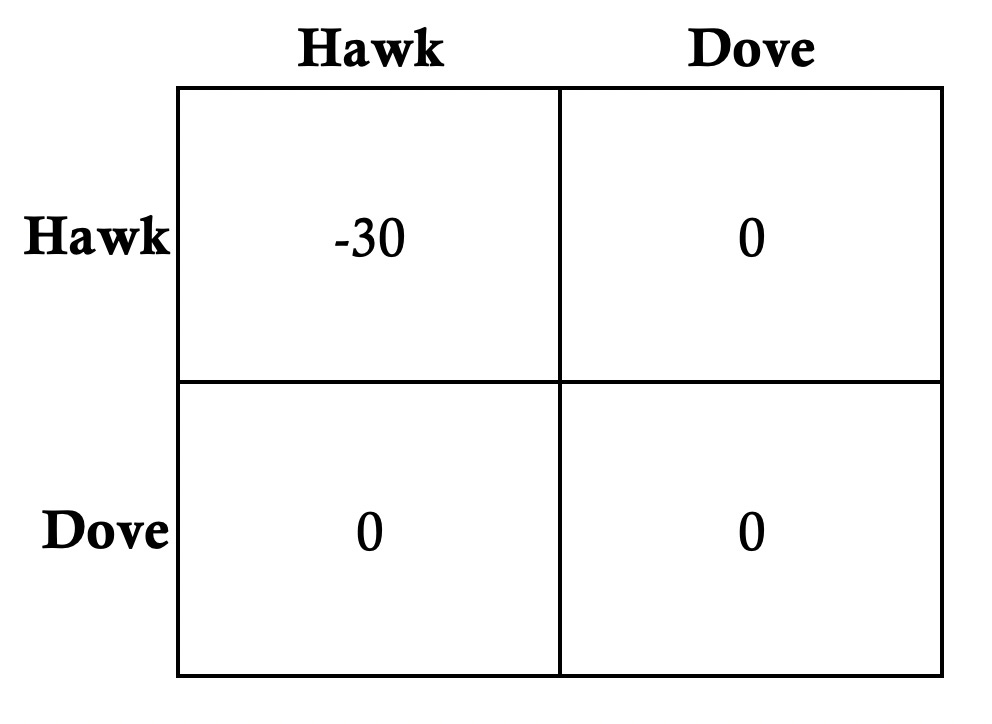
In absolute value terms, the higher the ratio of fitness payoffs for winning to losing, the more hawkish the population becomes. The reverse is also true: a lower ratio will induce a population to exhibit more overall dovishness. Said another way: when money is easy to steal, society slides toward kleptocracy, whereas when money is hard to steal, society becomes hard working. Skin in the game — the balance of incentives and disincentives in any system — is the most important determinant of behavior. In the sense of Universal Darwinism, lifeforms are complex adaptive strategies propagating through flesh, blood, and bone. By necessity, these strategies adapt to their environmental circumstances over time. Those that fail disappear. Evolution occurs as surely at the level of the individual organism as it does at the level of the collective species. And in the sphere of socioeconomics, no incentive is more powerful than money.
A set of timeless monetary principles permanently emblazoned in code, Bitcoin is a weapon of peace wielded by sovereignists to fight back against the ravages of systemized nation-state predation.
Bitcoin represents a mega-political variable of unparalleled importance: a private property right independent of all monopolies on violence that cannot be confiscated nor compromised by force. In the 21st century game of money, crime no longer pays. By necessity and on balance, market actors will adopt competitive and cooperative strategies that are longer term, less coercive, and vastly more productive. Progressing at an accelerating rate, technology will continue to eclipse topography, climate, and microbiology as the most critical mega-political variable in the Digital Age; and at the vanguard of this change is Bitcoin: a technology with human nature as one of its core operating components. No political force can contain the influence of Bitcoin’s intrinsic, inviolable incentives on human action and, hence, the rise of sovereignism.
The transition from statism to sovereignism could be chaotic in the near term, but the end result promises to be a more peaceful and productive global society. In Part 4, we will explore the origination of property as a concept and the commensurate rise of organized crime in the world. Deeper knowledge of these fundamental socioeconomic elements will help us better understand what the future may hold in a world shaped by sovereignism.
Thank you for reading Sovereignism Part 3: Mega-politics, The History and Logic of Violence
Subscribe to my YouTube Channel: bit.ly/321Lzm0
Follow me on Twitter: https://twitter.com/Breedlove22
Stack sats with me, get $10 in free Bitcoin through this link: https://www.swanbitcoin.com/breedlove
Journey with me as I write my first book: https://bit.ly/3aWITZ5
If you enjoyed this, please send sats: https://tippin.me/@Breedlove22
Or, send sats via Lightning Network with Strike: https://strike.me/breedlove22
Or, send sats via PayNymID: +tightking693
Or, send dirty fiat dollars via PayPal: https://www.paypal.com/paypalme/RBreedlove
Or, send dirty fiat dollars via Venmo: https://venmo.com/code?user_id=1784359925317632528
Translations:
x
My sincerest gratitude to these amazing minds:
@real_vijay, Saifedean Ammous, Brandon Quittem, Dan Held, Naval Ravikant, @NickSzabo4, Nic Carter, @MartyBent, Pierre Rochard, Anthony Pompliano, Chris Burniske, @MarkYusko, @CaitlinLong_, Nik Bhatia, Nassim Nicholas Taleb, Stephan Livera, Peter McCormack, Gigi, Hasu, @MustStopMurad, Misir Mahmudov, Mises Institute, John Vallis, @FriarHass, Conner Brown, Ben Prentice, Aleksandar Svetski, Cryptoconomy, Citizen Bitcoin, Keyvan Davani, @RaoulGMI, @DTAPCAP, Parker Lewis, @Rhythmtrader, Russell Okung, @sthenc, Nathaniel Whittemore, @ck_SNARKs, Trevor Noren, Cory Klippsten, Knut Svanholm @relevantpeterschiff, Preston Pysh, @bezantdenier
And anyone else I forgot :)
SOURCES:
Part 3:
Subscribe to The Freedom Analects
Written works exploring truth, power, freedom, money, economics, virtue, sovereignty, philosophy, and other enigmas of existence.






